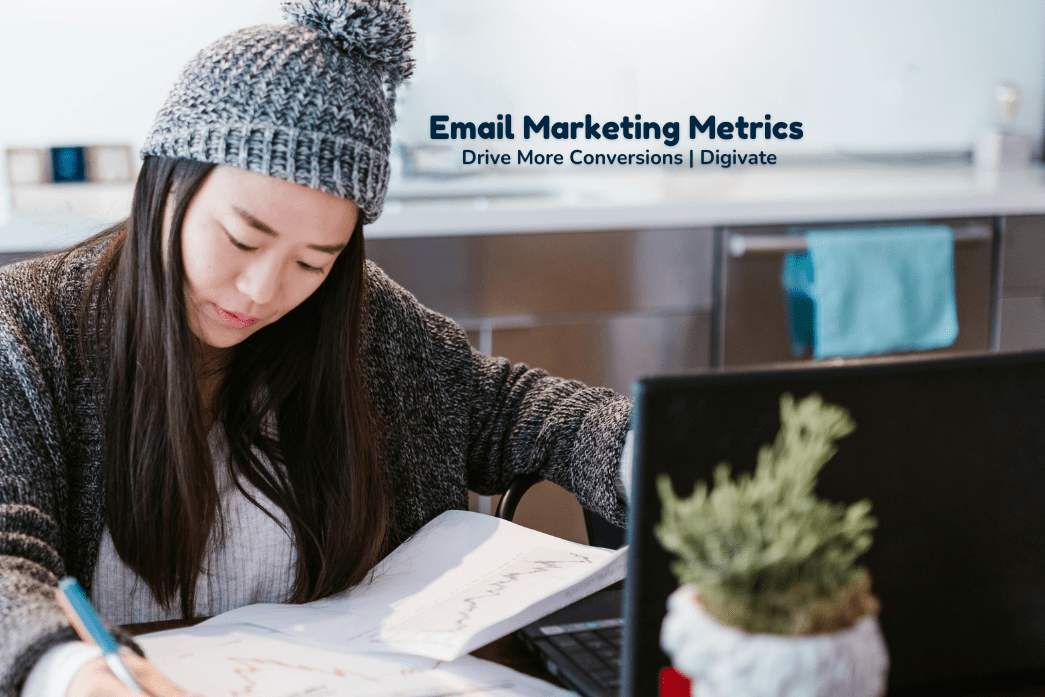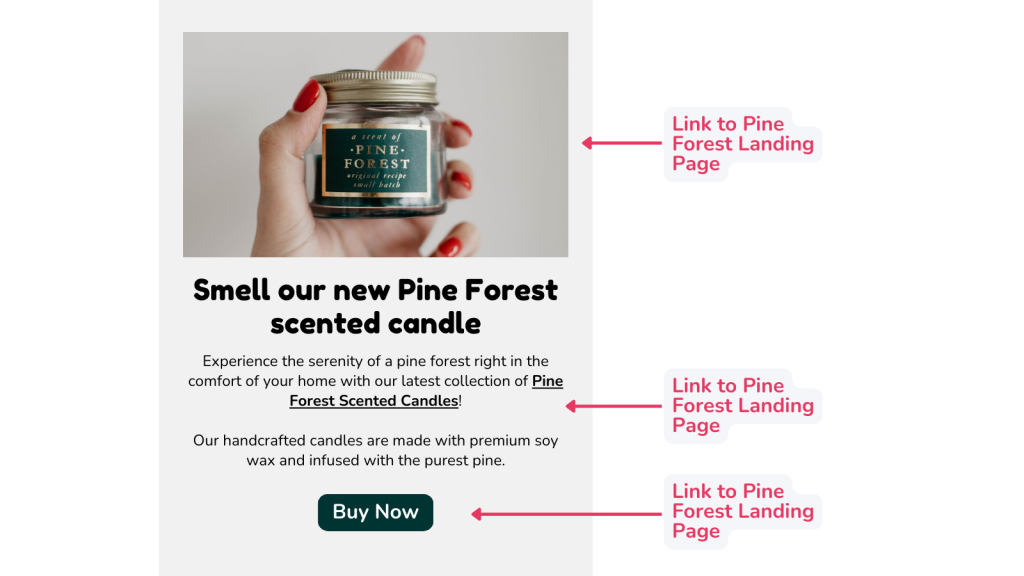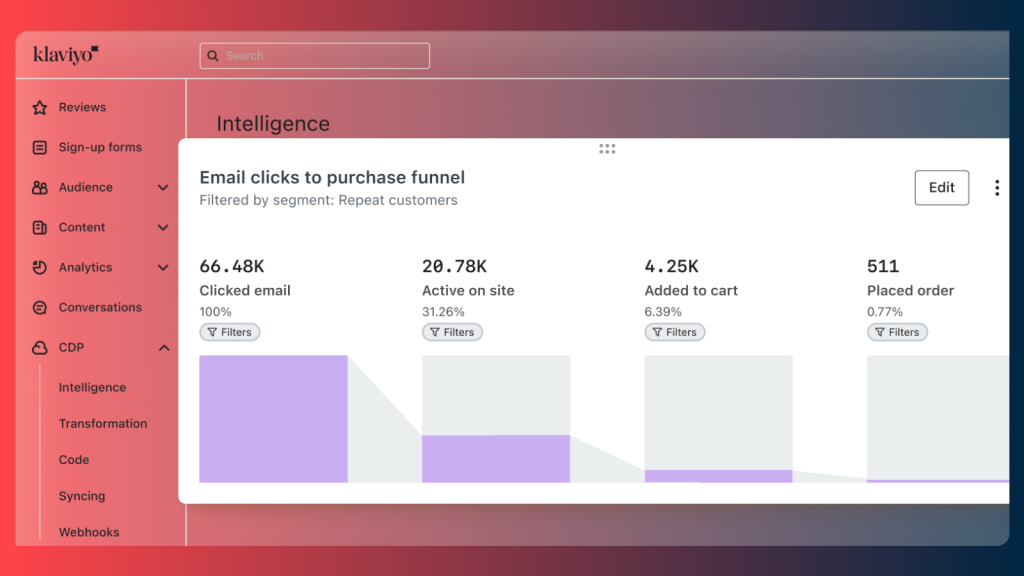
Email marketing platforms like Mailchimp, Hubspot and Klaviyo give you a lot of analytics. But which data should you pay attention to and how should you respond?
Today, we’re taking a deep dive into the world of email marketing performance metrics and how they can be the game-changer for your digital strategy.
Understanding these metrics will enable you to:
- Send the right amount of emails
- Segment your lists strategically
- Improve your email subject lines and preview text
- Optimise your email body for conversions
The conversion connection: which email marketing metrics to track
You want those clicks to turn into customers and your subscribers to become loyal advocates. But there are many steps to conversion. So how do you know if your email marketing strategy is paying off? Enter: metrics.
We recommend keeping a close eye on these five key email marketing metrics:
- Open Rate
- Click-Through Rate
- Conversion Rate
- Bounce Rate
- Unsubscribe Rate
We all have different goals for our email marketing campaigns. So it’s important to consider your metrics in terms of how they’re helping you achieve yours. If it’s sales, you’ll need to integrate your CMS’s analytics with your email platform to see the whole picture.
Open Rate
Your open rate is the percentage of recipients who open your email, and it sets the stage for everything that follows. A killer subject line and intriguing preview text are key!
What is the average open rate for email marketing?
The average open rate of emails across all industries is 22.61%, according to Mailchimp. But the majority of these emails are sent by professionals who aren’t exactly marketing pros. So if your open rate is sitting around or below the 20% mark, you might have some work to do.
How to improve your open rates
Finance Online reported in 2023 that ‘64% of recipients decide to open or delete emails based on subject lines’.
Subject lines that perform best:
- Introduce something new (a product, programme or idea)
- Raise a question that will be answered in the email
- Mention an offer or discount
If your open rates are looking low, the first thing to do is look at your subject lines. Create a spreadsheet with your past fifty subject lines and corresponding open rates to see which are performing best. Then apply what you learn along with the three tips above.

“If you’re seeing low open rates in combination with high unsubscribe rates, you might want to reduce how often you send and do more segmenting.” – Tess O’Bamber, Email Marketing Specialist
Click-Through Rate
The next hoop you want your recipient to jump through is the click. Your click-through rate (CTR) tells you the percentage of openers who clicked on one or more links in your email.
What is a good click-through rate?
The average click-through rate for email is 2.91% (Mailchimp). This may be satisfactory for your newsletters and brand awareness campaigns, but for conversion-focused emails, you’re probably aiming a bit higher.
How to improve your click-through rates
- Consider a more relevant subject line. Has the body of your email failed to live up to the expectations set in the subject? The connection between your CTR and subject line is proven to be pretty huge.
- Make your emails more user-friendly. If they’re visually unappealing, stuffed with text, or confusing to navigate, the recipient will give up before they find your links. You can also focus on clear, concise communication when you send a text using your email account to ensure your message grabs attention and encourages engagement.
- Focus on one clear call to action (CTA). Emails with a single focus perform better. Decide what it is and link the target landing page in your images, relevant text and a big button at the bottom.

Click Rate
The click rate is the percentage of recipients who clicked on one or more links in your email. As this includes those who didn’t open it, we usually focus on the CTR!
Conversion Rate
So, they’ve clicked your link. But did they ditch your site after two seconds or did they make it to the big moment?
An email marketing conversion rate is the percentage of people who completed your email’s desired action—whether that was filling out a form, downloading a resource, or buying a product.
How to work out your email marketing conversion rate
Most email platforms won’t automatically provide you with a conversion rate as they don’t know your desired action. Because of this, many marketers judge their emails based on the click rate. But calculating each email’s conversion rate is incredibly beneficial – it tells you whether your audience is engaging with your business in a meaningful way.
To work out your conversion rate, you’ll need to integrate analytics relating to your desired action, then divide the number of users who completed this action by the number of clicks. e.g. winter sale orders made ⨸ unique clicks = conversion rate. Platforms like Klaviyo make this really easy.

How to improve your conversion rates
This one’s more complicated! It could be that something on your landing page or something in the email was an obstacle to conversion. Or both!
It’s important that the page you sent clickers to provides exactly what users were expecting when they clicked. Did you hype up a sale that was actually quite small? Did you promote a range with images of a sold-out product?
- Check that your landing page meets and even exceeds expectations.
- Next, analyse your landing page in its own right. Is it easy to navigate? Have you included an option to ‘book a free consultation’ or ‘buy now’ above the fold?
- Look at the big picture. Maybe you wrote a great email that enticed users to click, but it wasn’t the right time for them to take the desired action. This is where segmentation becomes important.
You can send an email to a select portion of your list based on engagement history, site visits, demographics, product interests and more. According to Email Tool Tester, abandoned cart emails convert 3x more than other automated emails. If you don’t have automations like this set up, it will be harder to speak to the right people at the right time.
Bounce Rate
Bounce rates tell you the percentage of emails that couldn’t be delivered to the recipient’s inbox.
There are two types:
- Hard Bounce: The user’s email server might have rejected your email thinking it was spam (and not even worthy of the spam folder) or the recipient’s email address may not exist.
- Soft Bounce: The user’s mailbox is too full, the email server is down, or your message is too large.
Anything below 2% is considered an acceptable email bounce rate, but if it’s any higher than this, you should take action. Once a server has flagged you as a spammer, the situation can snowball.
How to improve your bounce rates
- Clean your email list in case any dodgy addresses have found their way in.
- Avoid language that causes anxiety, creates an excessive sense of urgency, or is otherwise spammy.
- Send marketing emails from an appropriate domain, not your Gmail.
- Personalise your emails.
- Ensure you are compliant with GDPR.
Unsubscribe Rates
Many marketers say you shouldn’t pay too much attention to unsubscribe rates. After all, you don’t want to pay for recipients who aren’t interested in what you’re offering. This is true, but we like to dig a bit deeper.
Is the unsubscriber not interested or did they just not like the way you were communicating with them?
How to improve your unsubscribe rates
Often, you’re simply sending too many emails. If your open rate is low, this is pretty likely. Many brands include a form on their unsubscribe page inviting users to subscribe to ‘just one email a month’ instead.
According to Gartner, ‘too many emails’ is the number one trigger for consumers to unsubscribe. But each user is unique. Have you tried segmenting your audience by their engagement rate?
The next question is whether you were sending this user irrelevant or generic content, rather than personalising their emails. When you segment campaigns to target users who are interested in a particular side of your business, you’ll see far fewer unsubscribes.
Klaviyo’s segment growth tool is pretty dope.
Unsubscribe rate can easily be misinterpreted when you ramp up volume in a big way around sales periods.
But that group of people falling out of the segment paints a very clear picture. pic.twitter.com/gRBySrLOhF
— Jacob Sappington (@jsappington) November 29, 2023
Another common cause of unsubscribes is that people only signed up to receive a special offer, freebie or something else from your lead generation strategy. This drop-off is a fact of email marketing life, so don’t worry too much about it.
That said, if you’re consistently retaining a very small number of your new leads, you might need to woo them a little more! Set up an automated customer journey/flow, rather than a welcome email with a single reward. Include additional free content and/or offers to show them that they will continue to receive value as a subscriber.
What to do with your email marketing performance metrics
We recommend checking each email’s performance the day after sending and reviewing your key metrics across campaigns once a month.
It’s often easiest to analyse email marketing metrics in a spreadsheet format. This way, you can notice irregularities and interpret them. E.g. a super high open rate with a minuscule click-through rate = the email’s content or CTA didn’t meet the expectations raised in the subject line.
Once you’ve got an idea of how to solve your recurring problems, try A/B testing your next campaigns. This means that two portions of your email list will receive variations of an email and the best-performing version will be sent to everyone else. Just make sure to only A/B test one thing at a time, whether that’s your subject line, header image or button text.
Achieve better email marketing results
Are you struggling to get results from your email marketing? Take it easy on yourself! Analysing these metrics is a tricky business and fixing the problems is even harder.
Once you’ve nailed it, though, email will be one of your most lucrative marketing activities. According to Salecycle, 50% of people buy from marketing emails at least once per month!
At Digivate, we come alongside your business to analyse your data, create compelling content, and share our email marketing expertise. Get in touch today to find out how we can help you turn sends into opens and clicks into conversions!



